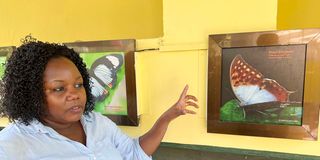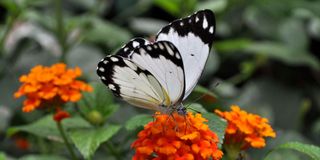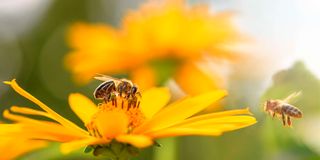On the brink: The fight to save pollinators and their habitats

Dr Maria Fungomeli at the Butterfly House in Mombasa on April 14, 2025.
What you need to know:
- With over 40 per cent of bees vanishing in just 14 years and economic losses now hitting Sh14.34 billion yearly, this isn't just about missing honey. It's about missing meals.
Ever noticed how the hum of bees can suddenly make you aware of a world you usually tune out? In Kenya, that familiar sound is fading into an eerie silence—and farmers are getting worried. Their avocados are getting smaller, coffee yields dropping, and watermelons are not quite as sweet.

Some of the butterfly species found in Mombasa.Kenya is home to around 870 butterfly species, with over 300 found in Arabuko Sokoke Forest alone. However, the numbers have dropped by more than 30 per cent due to habitat loss, deforestation, and climate disruptions.
With over 40 per cent of bees vanishing in just 14 years and economic losses now hitting Sh14.34 billion yearly, this isn't just about missing honey. It's about missing meals.
The butterfly effect
Inside the expansive Arabuko Sokoke Forest along the Mombasa-Malindi Highway, Dr Maria Fungomeli watches butterflies tell a disturbing story about the changing climate.
"Butterflies are not just a visual delight but one of nature's most sensitive indicators of environmental health," she explains as a brilliant blue specimen lands on a leaf.
"Their lives are so closely tied to climate, vegetation and seasonal rhythms that even slight disruptions trigger noticeable changes in their behaviour and survival."

With over 40 per cent of bees vanishing in just 14 years and economic losses now hitting Sh14.34 billion yearly, this isn't just about missing honey. It's about missing meals.
Kenya is home to around 870 butterfly species, with over 300 found in Arabuko Sokoke Forest alone. However, the numbers have dropped by more than 30 per cent due to habitat loss, deforestation, and climate disruptions.
"Globally, approximately 18,000 species are known, with 3,600 in Africa, but these populations are shrinking fast," notes Dr Fungomeli, who manages the Mombasa Butterfly House. "The decline is a troubling sign of broader environmental changes."
Rising temperatures have caused earlier emergence from pupae, altered mating patterns, and mismatches between caterpillar hatching and food plant availability. In some cases, extreme heat can even kill butterfly larvae.
This matters because butterflies are key pollinators.
"Without them, many plants would struggle to reproduce. This has ripple effects on food security and entire ecosystems," explains Dr Fungomeli.
The silent fields
The butterfly story is just part of a broader crisis. Between 2021 and 2022, Kenyan beekeepers lost more than a third of their colonies – 36.6 per cent gone. During hot, dry seasons, nearly 32 per cent of bees disappeared.
That's a far cry from the 1980s, when Kenya had around two million bee colonies producing 100,000 tonnes of honey annually. By 2018, the country's beehive count had fallen to just over 1.5 million.
This vanishing act threatens Kenya's agricultural economy. The horticulture sector, heavily dependent on pollinators, generated approximately Sh157 billion in 2023. Even with declining populations, bees still enabled production of 17,151.1 tonnes of honey valued at Sh 5.1 billion that year.
But their true economic value lies in crop pollination. Research in Murang'a County demonstrates this starkly: avocado branches accessible to pollinators produced 185 per cent more fruit than branches where pollinators were excluded. Insect-pollinated avocados weighed 213.7g compared to just 95.1g for self-pollinated fruits.
It's the same story all over Kenya. Watermelons yield 91 per cent more with bee help. Sunflowers produce 53 per cent more seeds when insects come calling. Even greenhouse tomatoes get significantly heavier with bee pollination.
A problem you can see on your plate
Think about what you ate today. Coffee for breakfast? It's 80 per cent dependent on pollinators and brings Kenya Sh 29.4 billion yearly.
Avocado toast? Those avocados are 95 per cent dependent on bees and worth Sh16.3 billion to the economy. Tomatoes, mangoes, macadamia nuts, watermelon – they all need pollinators to thrive.
"We're watching these creatures vanish before our eyes," says Dr Muo Kasina, an entomologist at the Kenya Agricultural Livestock Research Institute. "Managed honey bees are down to 59 per cent of what we saw in 2010, wild bees to just 50 per cent, and butterflies to only 42 per cent. That's a massive drop in just 14 years."
Why is this happening?
Two big culprits: climate change and disappearing habitats.
Kenya's weather patterns are getting weird. The March-April-May rains start later and finish earlier in many regions. That means less time for plants to flower, translating to less food for bees and butterflies.
Severe droughts in 2016-2017 and again in 2021-2022 caused pollinator populations to plummet.
The government tried to help with a National Pollinator Strategy in 2018, which gave managed honey bees a small boost, but wild pollinators keep declining.
Then there's the habitat problem. Between 1980 and 2000, Kenya lost nearly half its forest cover – about 300,000 hectares gone. Since 2001, another 19 per cent of tree cover has vanished. In places like the Mara River Basin, forests are disappearing at nearly two per cent per year.
Dr Fungomeli notes that butterflies are increasingly found outside their traditional habitats. "As their original ecosystems become unsuitable—either too hot, too dry, or stripped of crucial vegetation—they are forced to migrate. We're seeing movements into higher altitudes and different regions."
While the arrival of non-native butterfly species isn't yet widespread in Kenya, she warns that "it is a question of when, not if. Climate change, combined with human activity, creates conditions that allow species to expand into new territories."
The perfect storm
When researchers break down what's hurting Kenya's pollinators, it's a mix of problems: habitat loss causes about 35 per cent of the decline, pesticide use contributes another 25 per cent, climate change adds 20 per cent, parasites and diseases bring 12 per cent, while monoculture farming and invasive species make up the final eight per cent.
These threats hit hardest in specific regions. The Central Highlands, Western agricultural belt, and Coastal zone are seeing pollinator populations drop by more than half. The Rift Valley and Northern highlands are doing slightly better but still losing 30-50 per cent of their pollinators.
Finding hope in small wings
Despite these challenges, Kenyans are innovating solutions that work.
In Kitui County, beekeepers switching from traditional log hives to modern Langstroth hives are seeing big efficiency improvements. When Nyeri County invested Sh1.8 million in modern apiary kits for community groups, they generated Sh3.1 million in return.
Some farmers have found completely new ways to make a living while protecting nature. Through the Kipepeo Centre initiative – people have started farming butterflies while learning about forest conservation. They earn between USD 0.50-2.00 per butterfly pupa, bringing in up to USD 400 monthly.
One notable example is the Papilio dadamus, a flagship butterfly species known locally as the "flying handkerchief."
Dr Fungomeli explains that it's highly valued for export—fetching about $1.75 per specimen—and plays a crucial role in local butterfly farming initiatives.
"Butterfly farming not only supports conservation but also provides income to communities in Kilifi, Taita Taveta, and Kwale counties. It's a beautiful model of how local action meets global environmental needs," she says.
Even city spaces are joining the fight. Studies at the Nairobi Museum Botanic Garden show that urban green spaces with diverse plants can support thriving bee populations.
What works best?
Not all solutions are created equal. Creating flower-rich habitats scores 8.5 out of 10 for effectiveness. Reducing pesticides ranks even higher at 9.0. Bee hotels and hives (7.5), public education (6.8), and policy changes (5.4) all play supporting roles.
Farmers across Murang'a County are embracing these changes. Their farms look different now – flowering hedges separate crop plots, and patches of native plants dot the landscape.
"My yields have actually gone up," says one avocado farmer. "And I'm using less pesticide, which saves money. The avocados are bigger too – the buyers prefer them."
Many have installed bee hotels – small wooden structures with hollow tubes where solitary bees can nest. These wild bees are excellent pollinators for many crops but need suitable habitats to survive.
The knowledge gap
Awareness remains a critical gap. Despite pollinators underpinning Kenya's food systems, only about one in four Kenyans fully understand their importance, while over a third know almost nothing about these essential creatures.
As Grace Muthumbi, who leads a community conservation programme in Machakos County, puts it, "That tiny buzz you hear in your garden? That's the sound of food security." And preserving that sound isn't just for experts – it's something every Kenyan can contribute to.
Grace runs workshops for small-scale farmers, demonstrating the difference pollinators make. In one exercise, she covers some watermelon flowers with fine mesh to keep bees out, leaving others accessible. "When they see the difference in the resulting fruits, it's like a light bulb goes on," she laughs. "Suddenly they're asking how to attract more bees!"
Reasons for hope
Back in Arabuko Sokoke Forest, Dr Fungomeli watches as a bright yellow Papilio dadamus lands on a nearby flower. "This species has become a symbol of how conservation and livelihoods can work together," she says.
"Communities now protect the forest because they understand its value, not just in abstract terms, but in very practical, economic ones."
Through her work at the Mombasa Butterfly House, she has seen attitudes change. "People come to see the butterflies because they're beautiful, but they leave understanding why they matter. That's how change begins."
"Butterflies are not just insects; they are storytellers of our time," she reflects. "They help us understand what's happening to our world—and what we must do to save it."


